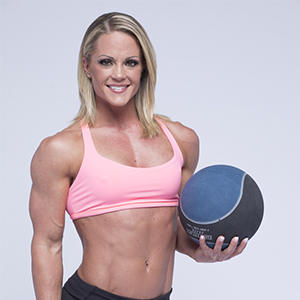How many times have you heard women should train only with light weights or risk getting too big? A lot, I’m sure.
If you’ve been a member of this site, or followed me on social media for a while, then I’m sure you know there’s a lot more to gaining muscle than just lifting heavy weights.
But before I get to that, I want to say this first because it is very important: training only with light weights for high reps every workout is not the best way to develop your physique. In fact, to keep moving forward to reach your goals, you need to go heavier and change up your rep scheme periodically.
Heavy or light in weight training is relative to an individual’s own strength. For example, squatting 225 pounds is heavy for me, but for a powerlifter it would probably be considered light. So when talking about the amount of weight used, it’s more accurate to refer to the number of reps a person can do with a certain weight.
Here’s a look at the different rep ranges, how they affect your muscles, and why you should use them all to improve your physique. 👍
LOW REPS
When you use a heavy weight that you can do only 1-5 reps with, you are primarily recruiting fast-twitch muscle fibers, the ones most responsible for muscle size (you also recruit slow-twitch fibers, but because they are not strong enough to lift the weight, the fast-twitch fibers take over). This is the rep range commonly used by strength athletes, like powerlifters and Olympic weight lifters. Their prime objective is getting stronger to lift the maximum weight possible for one repetition (1RM = one rep max). 🏋️♀️
Training in this low-rep range focuses primarily on your neuromuscular and central nervous system response, which increases motor unit recruitment to generate more force (strength).
MODERATE REPS
Reps in the 8-12 range are considered the “sweet spot” for building muscle. The weight you use will be heavy enough to tax the central nervous system but allow you to do enough reps to prolong time under tension. This increases lactic acid production (the burn), which in turn increases hormone levels in your body, specifically the anabolic ones such as testosterone and growth hormone.
Also, contracting and elongating your muscle with a heavy enough weight creates micro tears in the muscle (which is what we want). And of course, there’s the much sought-after pump. Getting blood into the muscles activates protein synthesis to start the repair process. This is why bodybuilders prefer this rep range. 💪
HIGH REPS
Reps above 15 involve slow-twitch fibers and are used primarily to improve muscular endurance. Although you are lifting light weights, there may still be some size and strength gains but it is best to do some heavier lifting to incorporate both muscle fiber types to maximize your results.
REP YOURSELF
As anyone who visits my site regularly or does any of my Challenges knows, you cannot do the same workout day in and day out and expect continuing results. Your body adapts to training – all types of training – so you have to keep changing things up. This goes for the amount of weight you use and the number of reps you do.
There are reasons for training with all the different rep ranges. It really depends on your personal goals and experience. Here’s a rep recap:
• Training heavy with low reps improves strength and power and is the preferred range for strength athletes, but can also be very helpful in endurance type racing to build speed.
• Training with moderate weights for moderate reps increases time under tension, which is best for hypertrophy (muscle building) and why bodybuilders train within this range.
• Training lighter with higher reps improves muscular endurance. It is also good way to give your joints a rest from the pounding of heavy weights and to maintain your strength and muscle size. This rep range is great for those just getting started into weight training so you can focus on form and reduce your risk of injury.
Alternate between the different rep ranges to utilize both slow- and fast-twitch muscle fibers and increase your natural growth hormone and testosterone levels. Try doing 2-4 weeks of moderate reps (8-12), 2-4 weeks of low reps (1-5), and 2-4 weeks of high reps (15+) as part of a periodization program.
In future articles I’ll address other factors, such as exercises, training splits, intensity techniques, and all the other things you can do to keep your workouts fresh, fun, and effective. 👏
Looking for more awesome training and nutrition information? Join NicoleWilkins.com for hundreds of workouts, training and nutrition tips, healthy recipes and more to help you transform your body and reach your fitness goals!
Become a Member Today!
ABOUT NICOLE
 One of the biggest names in the fitness industry, Nicole Wilkins is a world-record holding four-time Figure Olympia Champion and 2012 IFPA Personal Trainer of the Year. Nicole earned her BA in Wellness, Health Promotion and Injury Prevention at Oakland University. The owner and founder of nPower Nutrition, Nicole has helped thousands of people start living a healthier lifestyle and reach their fitness goals.
One of the biggest names in the fitness industry, Nicole Wilkins is a world-record holding four-time Figure Olympia Champion and 2012 IFPA Personal Trainer of the Year. Nicole earned her BA in Wellness, Health Promotion and Injury Prevention at Oakland University. The owner and founder of nPower Nutrition, Nicole has helped thousands of people start living a healthier lifestyle and reach their fitness goals.



Great information! Going to incorporate!
Log in to reply